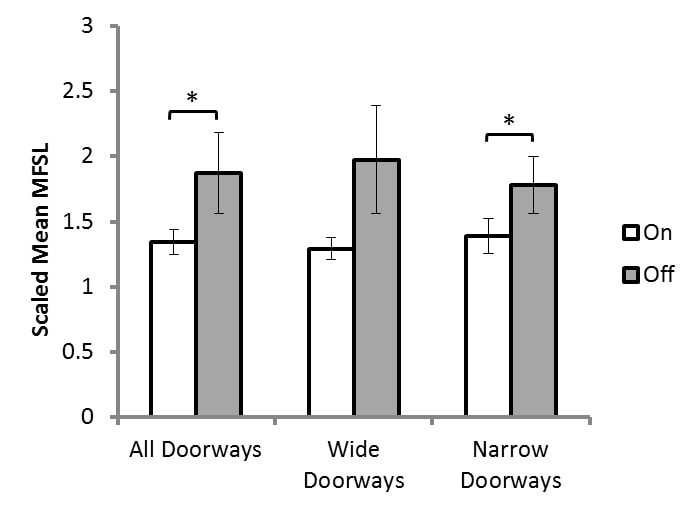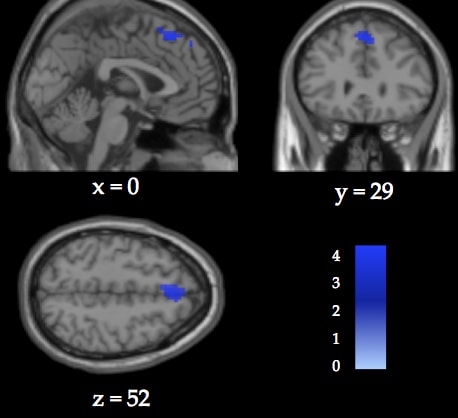Session Information
Date: Monday, October 8, 2018
Session Title: Parkinson's Disease: Neuroimaging And Neurophysiology
Session Time: 1:15pm-2:45pm
Location: Hall 3FG
Objective: We aimed to combine a previously validated virtual reality gait paradigm with functional Magnetic Resonance Imaging (fMRI) to investigate the neural correlates underlying doorway-provoked freezing behaviour in Parkinson’s disease. Based on previous models we predicted that disturbances in connectivity of the hyperdirect pathway would correlate with the motor disturbance observed in response to doorways.
Background: Freezing of gait (FOG) in Parkinson’s disease (PD) is frequently triggered upon passing through narrow spaces such as doorways. Often this freezing behaviour is improved with dopaminergic treatments. Despite being common the neural mechanisms underlying freezing are poorly understood due to the inherent limitations accompanying the functional imaging of gait. We have previously shown that freezing behaviour can be reliably modelled in a scanner using a virtual reality (VR) paradigm wherein subjects use foot-pedals to pass through a virtual corridor. Using this method, we have found that changes in activation within fronto-parietal networks contributes to freezing of gait generally but doorway-freezing specifically has not been studied.
Methods: In our study, nineteen patients who experience FOG performed a lower limb motor sequencing task wherein foot-pedals were used to navigate a series of wide and narrow doorways within a previously validated VR environment. Patients underwent testing both ‘ON’ and ‘OFF’ their medications and task performance together with blood oxygenation level dependent (BOLD) signal changes, were compared within each patient.
Results: Patients demonstrated significantly longer ‘footstep’ latencies in the OFF state compared to the ON state as they passed through a doorway in the VR environment (p<0.05). As with real FOG, this motor disturbance was primarily triggered by narrow doorways rather than wide doorways in the OFF state (Fig 1). fMRI analysis revealed that this footstep prolongation on passing through doorways was associated with specific hypoactivation in the pre-supplementary motor area (pSMA) bilaterally (p<0.05; Fig 2). Furthermore, task-based functional connectivity analyses revealed that increased latency in response to doorways was inversely correlated with the degree of functional connectivity between the pSMA and the subthalamic nucleus (STN) across both hemispheres (r = 0.441, p < 0.05). Conversely, increased frequency of prolonged footstep latency was associated with increased connectivity in bilateral STN (r = 0.575, p = 0.01).
Conclusions: The findings of this study suggest that the effect of perceptual cues on triggering FOG reflects impaired processing within the pSMA and its normal signalling with the STN thus implicating the ‘hyper-direct’ pathway in the pathophysiology of this phenomenon.
References: 1. Shine, J. M. et al. Modeling freezing of gait in Parkinson’s disease with a virtual reality paradigm. Gait Posture 38, 104 08, doi:10.1016/j.gaitpost.2012.10.026 (2013). 2. Matar, E., Shine, J. M., Naismith, S. L. & Lewis, S. J. Virtual reality walking and dopamine: opening new doorways to understanding freezing of gait in Parkinson’s disease. J Neurol Sci 344, 182-185, doi:10.1016/j.jns.2014.06.054 (2014).
To cite this abstract in AMA style:
E. Matar, J. Shine, P. Ward, M. Gilat, K. Ehgoetz-Martens, M. Frank, A. Moustafa, S. Naismith, S. Lewis. Identifying the neural correlates of doorway freezing in Parkinson’s disease [abstract]. Mov Disord. 2018; 33 (suppl 2). https://www.mdsabstracts.org/abstract/identifying-the-neural-correlates-of-doorway-freezing-in-parkinsons-disease/. Accessed December 4, 2025.« Back to 2018 International Congress
MDS Abstracts - https://www.mdsabstracts.org/abstract/identifying-the-neural-correlates-of-doorway-freezing-in-parkinsons-disease/


